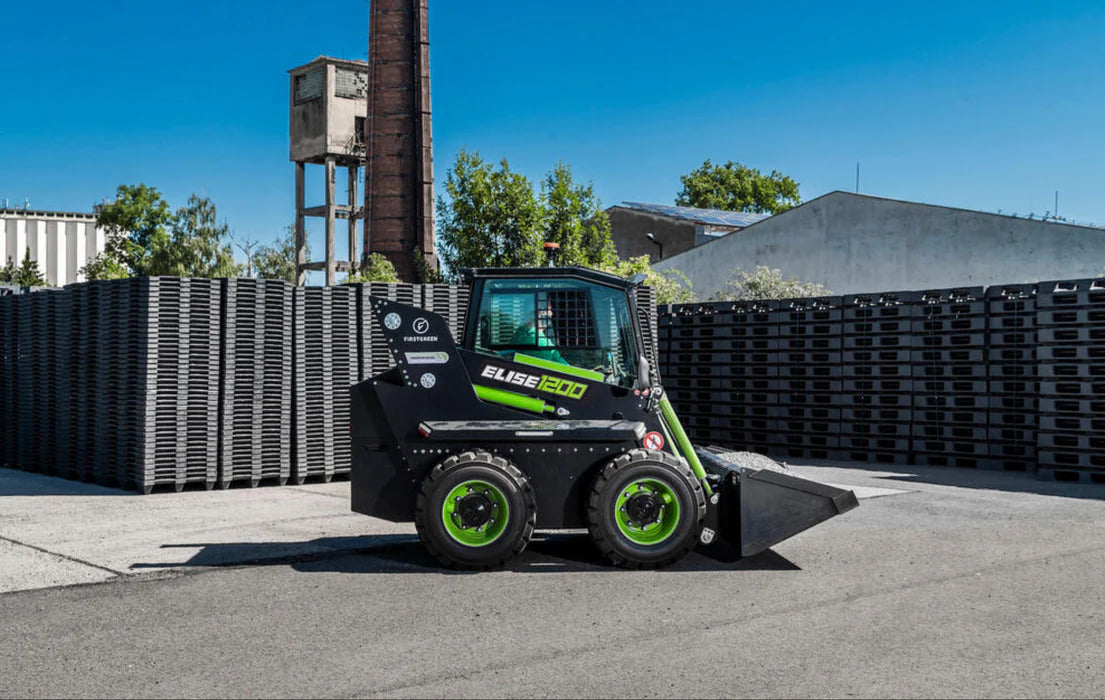
Electric vs. Diesel Skid Steers: What's the big difference?
Skid steers are indispensable tools in construction and agriculture, known for their versatility and efficiency. However, choosing between electric and diesel-powered skid steers can take time and effort. This blog post aims to compare these two types of skid steers, highlighting their biggest differences. It will also delve into the specific features and benefits of the First Green Industries Elise 1200 electric skid steer model.
Key Differences Between Electric and Diesel Skid Steers

1. Power and Performance: Diesel skid steers have long been the industry standard due to their robust power and performance capabilities. They come in a wide range of models with varying rated operating capacities (ROC), from as low as 760 lbs to as high as 4,200 lbs. Diesel engines are known for their longer run times and flexibility in operation, making them suitable for heavy-duty tasks and extended use.
On the other hand, electric skid steers, such as those offered by First Green Industries, provide immediate full torque without idling or startup time. While they may have shorter run times than diesel engines, their efficiency in power delivery and reduced maintenance needs make them an attractive option for many users.
2. Environmental Impact: Electric skid steers are significantly more environmentally friendly than diesel. They produce zero emissions, which helps reduce smog pollution and minimizes their carbon footprint. This makes them ideal for indoor use or in areas where air quality is a concern. Additionally, electric models operate much quieter, reducing noise pollution and making them suitable for urban environments or noise-sensitive areas.

Diesel engines, while powerful, emit greenhouse gases and other pollutants. Despite advancements in clean diesel technology, they still contribute to environmental degradation. However, diesel remains a highly efficient fuel source, carrying 38 kilowatt hours of energy per gallon, substantially higher than lithium-ion batteries used in electric models.
3. Maintenance and Operating Costs: Electric skid steers have fewer moving parts than diesel models, resulting in lower maintenance requirements. There are no engine oil changes, oil filters, spark plugs, or exhaust systems to worry about. This simplicity translates to reduced downtime and lower overall maintenance costs.

Conversely, diesel skid steers require regular maintenance, including fuel filter changes, oil changes, and other engine-related upkeep. While diesel engines are generally more durable and can handle more demanding tasks, the cost of maintaining them can add up over time.
4. Cost Efficiency: From a cost perspective, electric skid steers can be more economical in the long run. Although the initial purchase price of electric models, such as the First Green Industries Elise 1200 compared to basic diesel models—the savings in fuel and maintenance costs can offset this over time. For instance, the annual operating costs for the First Green MiniZ are around EUR 68, while the ELISE 900 costs approximately EUR 450 annually, based on average usage.
Spotlight on the First Green Industries Elise 1200 Electric Skid Steer

The First Green Industries Elise 1200 is a premier example of electric skid steer technology. This model is designed to offer extreme power, clean operation, and minimal noise, making it ideal for various applications, including farming, municipal work, and interior operations.
Key Features and Benefits:
- Efficient and Quiet Operation: The Elise 1200 operates efficiently with minimal noise, thanks to its electric drive and photovoltaic charging capabilities. This makes it suitable for environments where noise and emissions are a concern.
- Minimal Operating Costs: With an assumed average operation of 500 motor hours per year, the Elise 1200's operating costs are significantly lower than conventional diesel models. This cost efficiency is further enhanced by the lack of maintenance requirements typically associated with diesel engines.
- Versatility and Adaptability: The Elise 1200 can be equipped with a variety of electric attachments, allowing it to be customized for specific tasks. This adaptability makes it a versatile tool for different industries.
- Sustainability: As a 100% electric machine, the Elise 1200 contributes to a greener future by eliminating harmful emissions and reducing the overall carbon footprint.
In conclusion, electric and diesel skid steers have unique advantages and disadvantages. While diesel models offer power and flexibility, electric skid steers like the First Green Industries Elise 1200 provide a sustainable, cost-effective alternative with lower maintenance needs and environmental impact. The choice ultimately depends on the specific requirements of the task at hand and the long-term goals of the user.
Visit our website for more details at www.evolutionmechanical.ca. Contact our sales team at Sales: jon@evolutionmechanical.ca or by phone at 780-289-7888